Table of contents
- Hibernation for the motorcycle This is how you prepare your bike for the winter break
- cleaning
- tire
- Tank / fuel system / engine
- battery
- Oil change / coolant
- Mothballing
- Winter operation / corrosion
- Classic winter repairs
- Visual defects
- Maintenance work
- Materials needed
- Video: Prepare your motorcycle for the winter break
- Technician courses from Ralf Petersen
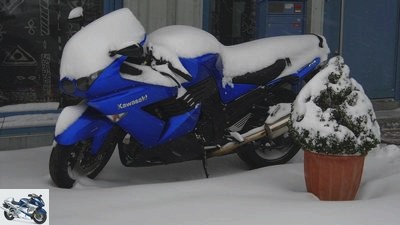
Andreas Bildl
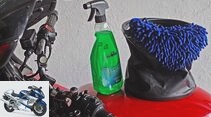
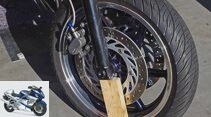
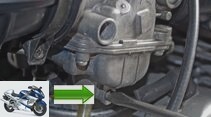
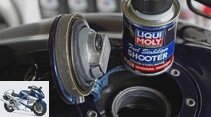
13th pictures
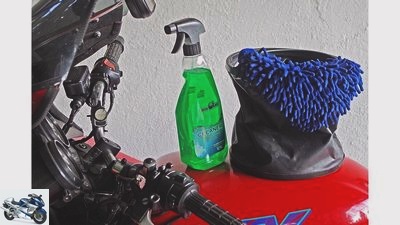
Petersen
1/13
Step 1: Big Wash – Thoroughly clean the motorcycle before winter.
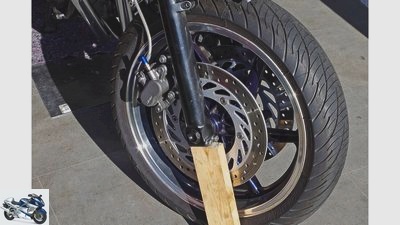
Petersen
2/13
Step 2: Jacked up – with more air pressure and without ground contact.

Petersen
3/13
Step 3: With carburettor engines – empty the float chamber.
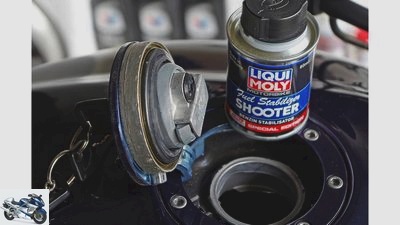
Petersen
4/13
Step 4: alternative for injectors – stabilizer against corrosion.
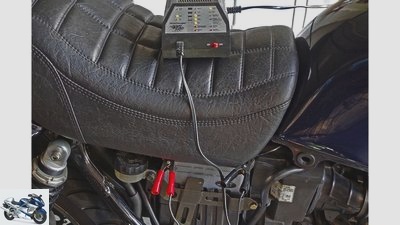
Petersen
5/13
Step 5: Against battery death – charger with maintenance function.
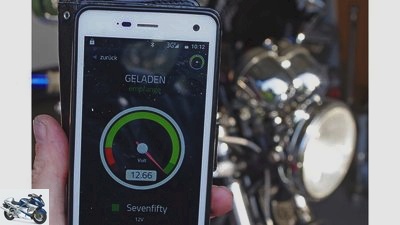
Petersen
6/13
Step 6: Nice gimmick – check the tension using the smartphone app.
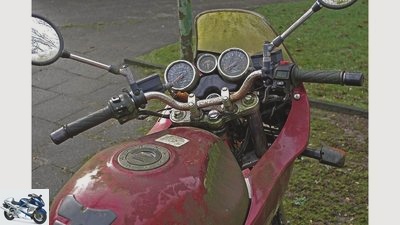
Petersen
7/13
Step 7: Better not that way – open-air motorcycle after a long period of idle time.
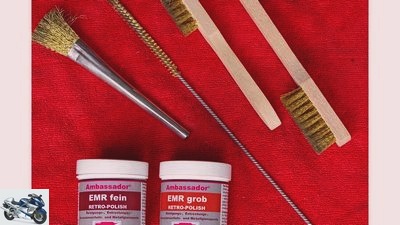
Petersen
8/13
Step 8: Miracle cure with preservation effect – EMR Retro-Polish.
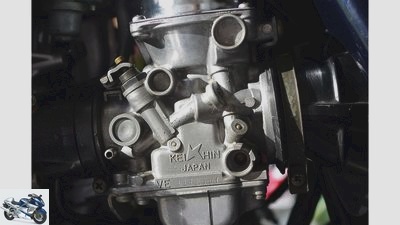
Petersen
9/13
Step 9: The screwdriver’s heart laughs – again finely polished carburettors.
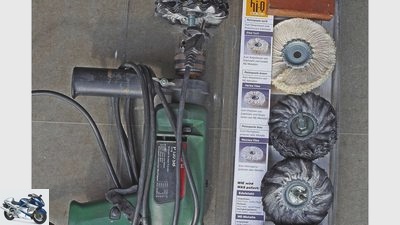
Petersen
10/13
Step 10: for stubborn cases – polishing set and drill.
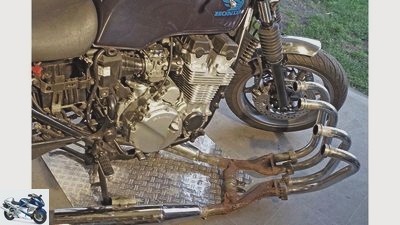
Petersen
11/13
Step 11: real major project – derusting an exhaust system.
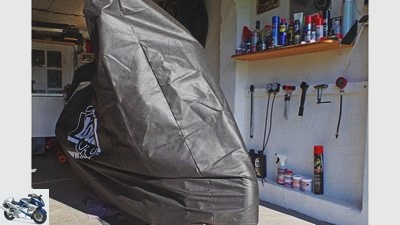
Petersen
12/13
Step 12: Well then “good night” – the winter can come!
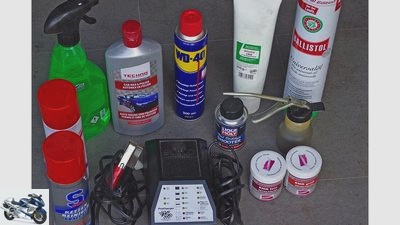
Petersen
13/13
Materials that are required to optimally prepare the motorcycle for the winter break.
counselor
workshop
This is how you prepare your motorcycle for the winter break
Hibernation for the motorcycle
This is how you prepare your bike for the winter break
The season is over, so off to the garage with your beloved saucer? Before there is a risk of withdrawal symptoms, you cold-drink a beer, pick up cleaning rags and tools and refurbish the motorcycle again.
Ralf Petersen
December 09, 2019
Modern motorcycles can actually cope with longer idle times. But if it is foreseeable that the machine will not be used, it should be shut down properly. Winter operation, on the other hand, means increased contact with moisture and possibly road salt. Aluminum and chrome parts, but also paintwork and electrics, can suffer from this. After all, winter also offers a good opportunity to carry out more complex maintenance work and repairs on the motorcycle in peace, to make improvements or modifications or generally to bring the look back into shape.
Buy complete article
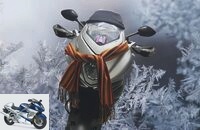
Screwdriver tip – prepare the motorcycle for the winter break
Tips & Tricks
4 pages) as PDF
€ 2.00
Buy now
cleaning
Dirt stores moisture like a sponge and thus automatically promotes corrosion. The motorcycle should therefore be cleaned as gently but thoroughly as possible – do not use a steam jet or high-pressure cleaner, this is poison for bearings and electrics! The chain also deserves special attention.
After removing dirt with a special chain cleaner and, if necessary, a nylon brush, the chain is well lubricated. The same applies to all lubrication points on the motorcycle that are specified in the maintenance schedule, such as levers, joints, etc. It is best to use clean engine oil, grease or Ballistol.
tire
At least in theory, tires cannot tolerate long-term stress in a particular place. Therefore, place the motorcycle on the main stand and support the front wheel on the fork (e.g. with a piece of wood) so that both wheels do not come into contact with the ground. If you don’t have a main stand, you need a corresponding assembly stand. Alternatively, you can turn the loaded wheel a little further every few weeks, but it’s very easy to forget.
In addition, the air pressure is increased by 0.5 bar. Tires: If the tires only have a low profile, it is advantageous to change them over the winter. In contrast to spring, when you have to be happy to receive the tire you want, there is usually room for maneuver in terms of prices and no time pressure for assembly.
Tank / fuel system / engine
A normal steel tank is not painted on the inside and would rust if it came into contact with moist air. This initially only slight rust film then dissolves in the gasoline and later possibly clogs the bores and channels in the carburetor / injection system. To prevent this from happening, the tank is filled to the brim with petrol. Logically, if you have a plastic tank, you don’t have to do anything. In the case of carburettor engines, the float chamber should also be emptied. Suspended matter and water collect here. During hibernation, the gumming then forms deposits, which can also cause problems when the system is restarted. Each float chamber has a special drain plug for emptying. This screw sits at the lowest point of the float chamber. It is enough to unscrew the screw a little with the fuel tap closed and let the fuel drain. Conveniently, you can often put a hose on the drain (sometimes it is already there). Then turn it off – done! However, the accessibility of the carburettors is not always optimal.
Often a piece of the frame, cladding or other component is in the way. With four-cylinder carburetor batteries you usually need an extra long screwdriver in order to be able to reach the drain plugs of the inner carburetor at all. In spring, the empty carburettors must be flooded again before starting. Logically, the fuel supply is opened again for this. On some motorcycles with a vacuum fuel cock, the cock must be set to PRI in order to be able to properly supply the carburettors with fresh fuel. After a successful start, however, do not forget to return the fuel tap to the normal position. Of course, owners of motorcycles with fuel injection systems do not have this option. You should therefore protect the fuel system with a petrol stabilizer (e.g. from Liqui Moly) that is added to the fuel. Observe the manufacturer’s information on use and mixing ratio.
battery
If you don’t want to shorten the service life of your battery unnecessarily, store it frost-free, clean the poles thoroughly and hang it on a charger with a maintenance function. If you do not yet have a maintenance-free battery, you must also check the acid level and top up with distilled water if necessary. Winter drivers leave the battery installed, of course, but also connect it to a suitable permanent charger. Otherwise start problems are programmed at low temperatures.
A battery guard can also be used to check the state of charge (not only during winter). Connected to the battery, a small transmitter transmits information about voltage to the smartphone via Bluetooth via an app. Handy when you have several motorcycles but only one charger. The installation of the transmitter is child’s play, as is the app installation. Checking the voltage display with a good voltmeter confirmed the exact display. However, the range of the transmitter is limited to two to five meters.
Oil change / coolant
If the engine oil change interval is almost reached anyway, an oil change makes sense right now. Older oil only has a part of the corrosion protection that fresh oil has, which also does not contain any aggressive components resulting from combustion.
In spring you can start the new season with new oil. If you own a motorcycle with water cooling, you shouldn’t forget to check the antifreeze, similar to a car. A corresponding test spindle is used for this.
Mothballing
Very picky people interrupt any possible air circulation in the engine / intake / exhaust tract. To do this, an oil-soaked rag is inserted into the intake port of the air filter and into the openings of the exhaust. As was customary in the distant past, dripping some oil into the cylinder is nowadays unnecessary.
Modern cylinder alloys can withstand longer service lives without complaint. Even in a dry garage, the motorcycle should also be covered with an air-permeable dust tarpaulin.
Winter operation / corrosion
The biggest problem in winter is corrosion. Even an actually dry garage is not a good choice if you regularly park a wet car next to the unprotected machine. Anyone who drives regularly in winter or does not have a dry parking space (garage, etc.) should take additional measures. Lantern parkers protect the machine with a waterproof tarpaulin. However, it is essential to ensure that there is sufficient air circulation. All unpainted metal parts are protected with a thin layer of oil (oil can plus rag or spray oil, e.g. Ballistol). Caution: do not spray anything on brake discs or tires! Painted surfaces can best be protected with commercially available car polish. The electrical system is also preserved as far as possible and accessible with WD 40 (switch and plug connections, spark plug connector).
Worst of all, however, are the corrosion damage caused by road salt. Rust attack on the exhaust system, “blooming” aluminum or light metal and short circuits in the electrical system are the usual problems. For this reason, the motorcycle should be thoroughly washed with plenty of water after using it on roads contaminated with road salt (engine block from below and exhaust system). The addition of heated handles is not only recommended for the winter time. This is not only comfortable, but also a safety gain, because with clammy fingers there is no feeling when accelerating and braking. When assembling, however, do not connect the cables directly to the battery, but prefer a circuit via a relay so that they only work when the ignition is switched on.
Classic winter repairs
Even when cleaning the motorcycle thoroughly, you often notice that the machine has suffered more than expected during the season. Some maintenance work may also have been postponed in order to drive rather than screw. And botch caused by lack of time can now be corrected in peace.
Visual defects
Chrome and aluminum, but also all other unpainted metal parts, become unsightly over time without proper care. Typical examples are e.g. the dip tubes of the telescopic fork and the exhaust system. If you drive on with parts that are already tarnished or through the winter, their condition worsens considerably. So it is better to prevent. There are two options here. If you can get to the relevant areas well, you can tackle the problem with appropriate care products. I have had excellent experiences with EMR Retro-Polish. This multifunctional paste from Ambassador-Chemie removes almost all traces of oxidation without much effort. Simply apply a thin layer and polish the surface with a cloth for a few minutes. EMR-Fein is sufficient for removing all normal signs of use, EMR coarse is needed for more stubborn cases.
There is also a practical range of brushes that you can use to get to the last nook and cranny. It is also good that the fat contained in the EMR paste also preserves the treated parts for some time. The product is also perfect for freshening up die-cast aluminum parts. The grayed-out carburetors on my Sevenfifty shine like new after EMR treatment. Alternatively, a polishing set can also be used. With the help of the appropriate attachments, polishing wax and a drill, you can get good results, but less gently and dismantling of the corresponding parts is usually necessary. The exhaust system is often a particular problem. In the areas that are not easily visible and difficult to access (collectors etc.), severe rust can occasionally be observed. This is not only visually very unattractive, the exhaust system can also rust through. The only thing that helps here is complete dismantling, diligent rust removal, polishing and painting.
Maintenance work
Whether pending maintenance work with a longer time interval (such as changing the telescopic fork oil, replacing the brake lines, replacing the chain set) or systematic overhaul due to a high mileage (replacement of steering head bearings, wheel bearings, etc.), the winter break can be used for this. The same applies to the assembly of accessories as well as conversions and changes to the chassis, exhaust and paintwork.
Materials needed
- cleanser
- Leg rate stabilizer
- polish
- Oil can
- Ballistol / WD 40
- fat
- Chain spray / chain cleaner
- possibly oil and oil filter
Material costs:
- Tarpaulin (from approx. 10 euros)
- Battery charger with maintenance function (from approx. 40 euros)
- Battery guard for voltage control via smartphone (Polo, approx. 30 euros)
- Polishing set (Polo, 34.95 euros)
- EMR Retro Polish coarse and fine (24.99 euros each, can be purchased from www.ambassador-chemie.de)
- Range of brushes
Video: Prepare your motorcycle for the winter break
\ n<div class = \&# 34; v-A_-custom-html v-A_-custom-html – video \ “>\ n<iframe width = \&# 34; 560 \&# 34; height = \&# 34; 325 \&# 34; src = \&# 34; https: //www.youtube.com/embed/GY52ibvZNs4 \&# 34; frameborder = \&# 34; 0 \&# 34; allowfullscreen></ iframe>\ n</ div>\ n</ div>\ n&# 34;,&# 34; consentGroup&# 34;: null}”>
Technician courses from Ralf Petersen
Ralf Petersen works as a further education teacher at the VHS Duisburg and has been organizing mechanics courses for 22 years. 12 to 15 practical seminars on maintenance, repair and technology are offered every year. In 2015, Delius Klasing-Verlag published his book “Basiswissen Motorrad-Technik”. Further information: www.icopter courses.de.ki To Ralf Petersen’s Facebook page
Related articles
-
Winter break: this is how bikers get over the compulsory break
Yamaha counselor Winter break: this is how bikers get over the compulsory break Winter break This is how bikers get over the compulsory break Winter…
-
Reconditioning used motorcycles winter break
Ralf Petersen 15th pictures Ralf Petersen 1/15 What is needed: repair instructions, compression meter, feeler gauge (for candles, valves), oil strainer,…
-
Winter motorcycle clothing for cold days
Schmid 9 pictures MPS studio 1/9 Thermoboy 365+: 59.90 euros, MOTORRAD verdict: satisfactory. MPS studio 2/9 BMW PCM undersuit: 240 euros, MOTORRAD…
-
Anlas motorcycle winter tires tested
factstudio.de 5 pictures factstudio.de 1/5 Turkey is not exactly known as a classic motorcycle or winter sports country. Nevertheless, a winter tire for…
-
Tips for mechanics – correct motorcycle chain maintenance
Photo: Ralf Petersen 13th pictures Ralf Petersen 1/13 / 1 / A typical lack of maintenance: everything sparkling clean, even the chain. Ralf Petersen 2/13…
-
to travel Winter tour Winter tour Caught cold In winter through the mountains on two wheels ?? a real challenge. And in the saddle of an almost…
-
Legal basis for motorcycle conversions
Fotalia 15th pictures Fotalia 1/15 Legal basis for the self-made custom bike. Ralf Petersen 2/15 First desk, then workbench. Nothing works without…
-
Scene: This is how mail-order motorcycle sales work
Bilski accesories Scene: This is how mail-order motorcycle sales work Scene: This is how mail-order motorcycle sales work Mail from Doreen… In addition…
-
This is how it works: motorcycle care
accesories This is how it works: motorcycle care This is how it works: motorcycle care With these tips, your motorcycle will sparkle again as if it were…
-
Payload on a motorcycle: This is how much weight can be on the bike
Klaus H. Daams counselor Driving experience & Driving tips Payload on a motorcycle: This is how much weight can be on the bike Payload on the motorcycle…